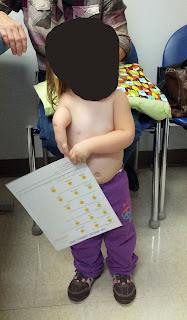Ulnar deficiency, as described in a previous post has characteristic findings at the elbow, forearm, and hand. http://congenitalhand.wustl.edu/2011/09/ulnar-longitudinal-deficiency-basics.html
Most classifications describe 4 types of ulnar deficiency (or ulnar longitudinal deficiency- ULD). These classifications only address the bony deficiency (and not the important other issues such as muscles, tendons, nerves, etc). While there are a number of classifications, the basic description is as follows:
Type I is a slightly short ulna
Type II is a notably short ulna
Type III is an absent ulna
Type IV is a completely absent ulna with fusion of the radius and the humerus.
We have helped to extend the classification in both directions. When the ulna is normal and there are only abnormalities of the hand (such as metacarpal synostosis, absent digits, etc) , this can be described as a Type 0 ulnar deficiency: http://www.ncbi.nlm.nih.gov/pubmed/16344190
On the other end of the spectrum, some kids have a severely shortened extremity. Traditionally, these children have been classified as having a phocomelia. Phocomelia (which will be the topic of another post) technically implies a segmental deficiency in which, for example the hand is attached to the arm (i.e., humerus) without a forearm. However, in another investigation we were able to demonstrate that most kids with a diagnosis of phocomelia actually have a diagnosis of either radial deficiency or ulnar deficiency: http://www.ncbi.nlm.nih.gov/pubmed?term=ezaki%20goldfarb%20manske
The importance of making the correct diagnosis cannot be understated, most importantly for 2 reasons: the genetics related to the diagnosis and the associated conditions. The genetics of a particular diagnosis will allow for information regarding the risks that the parents should understand for having another child with the same diagnosis and also the risk that the patient will someday have a child with the same diagnosis. The other issue is associated conditions. Some diagnoses carry a risk for associated conditions such as a heart or kidney problem whereas others do not. Therefore, making the correct diagnosis allows the ideal medical evaluation of the patient.
Here is an example of severe ulnar deficiency, or Type 5 ulnar deficiency. Note the short extremity and the three conjoined fingers.
 |
| Ulnar deficiency on right |
 |
| Another view of ulnar deficiency |
 |
| Note the 3 fingers with syndactyly in ulnar deficiency |
 |
| Radiograph of ulnar deficiency. There is one bone which has a split (kind of like a wishbone). There is no separate radius and ulna. |
Thank you very much.
I just want to send a big thank you for your fantastic blogg! We had our little Viljar in april 2012, and although I am a fysiotherapist I had no knowledge about this condition. Based on the classification above our son Viljar has a type IV ulnar defficiency, bilateral. He is now 21 months, and has showed us that he can do everything that any child at the same age can, and we sertainly hope and believe that the future will turn out to be just as good as the last 21 months. Now our biggest challenge is that we live in Tromsø in the northern part of Norway, and here it's winter atleast 6 months a year. Luckily we have an amazing wellfair system here in Norway, and he Viljar gets costom made mittens, bicycle steers and other things he might need whithout any cost for us. We live nearby the University hospital of North Norway, and gets alot of help here, and we have also visited Oslo University Hospital Rikshospitalet, this fall for surgery on his syndactyli.
So thank you again on all the information on this blog, it's fantastic to find this information on a condition thar is so rare that we of course have trouble to find someone to compare withe here in little Norway.
Please contact me if you have any interesst in knowing more about our little guy (and I apologize for my poor english). 🙂
Silvia.
Silvia, I am happy that the blog has been helpful. And congratulations on Viljar! Norway's welfare support is such a great thing for you guys although, as you have learned, Viljar is going to do just fine.